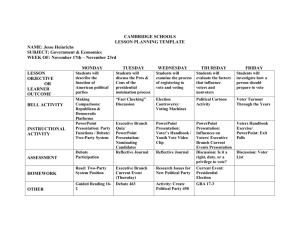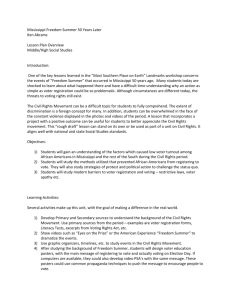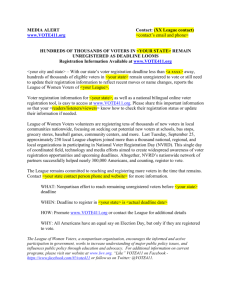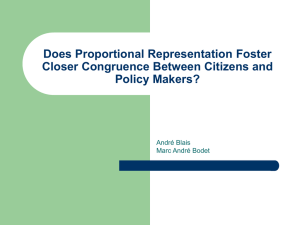Appendix: Defining and Calculating Shapley
advertisement
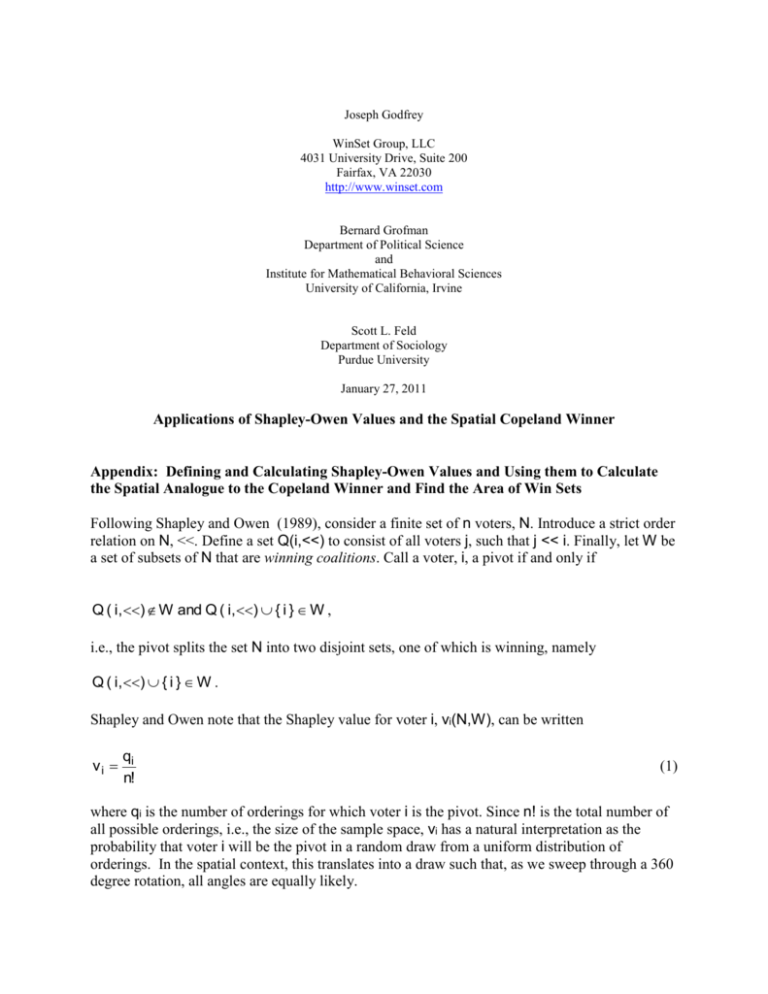
Joseph Godfrey
WinSet Group, LLC
4031 University Drive, Suite 200
Fairfax, VA 22030
http://www.winset.com
Bernard Grofman
Department of Political Science
and
Institute for Mathematical Behavioral Sciences
University of California, Irvine
Scott L. Feld
Department of Sociology
Purdue University
January 27, 2011
Applications of Shapley-Owen Values and the Spatial Copeland Winner
Appendix: Defining and Calculating Shapley-Owen Values and Using them to Calculate
the Spatial Analogue to the Copeland Winner and Find the Area of Win Sets
Following Shapley and Owen (1989), consider a finite set of n voters, N. Introduce a strict order
relation on N, <<. Define a set Q(i,<<) to consist of all voters j, such that j << i. Finally, let W be
a set of subsets of N that are winning coalitions. Call a voter, i, a pivot if and only if
Q ( i, ) W and Q ( i, ) { i } W ,
i.e., the pivot splits the set N into two disjoint sets, one of which is winning, namely
Q ( i, ) { i } W .
Shapley and Owen note that the Shapley value for voter i, vi(N,W), can be written
vi
qi
n!
(1)
where qi is the number of orderings for which voter i is the pivot. Since n! is the total number of
all possible orderings, i.e., the size of the sample space, vi has a natural interpretation as the
probability that voter i will be the pivot in a random draw from a uniform distribution of
orderings. In the spatial context, this translates into a draw such that, as we sweep through a 360
degree rotation, all angles are equally likely.
Shapley and Owen remark that it seems unlikely all possible coalitions of equal size have an
equal probability of forming in actual political situations, as required for the probability
interpretation of (1). Accordingly, each has suggested formal modifications of (1), the upshot
being to modify (1) to reflect a more realistic sample space (see Shapley and Owen, 1989 for
discussion and references). In the spatial context, the structure of voter proximity shapes the
coalition structure.
SOV in Proximity Spatial Voting Models
A particular modification of (1) proposed by Shapley involves a spatial voting model (Shapley,
1977). Shapley’s model consists of a finite set of n voters, N, a set of subsets of N, called winning
coalitions, W, and a set of n points {Pi}, i N , in an m-dimensional affine (or projective) space,
m , representing the voters. These points, called ideal points, represent the preferred policy
outcomes of each voter. The space is assumed to be measurable (Lebesgue) with a Euclidean
metric, d(x,y) and inner product, <x,y>. In fact, d(x,y) = |<x,y>|1/2.
Shapley considers unit vectors U m . These vectors lie on the unit sphere Hm-1, each vector
defining a direction in the space. Furthermore, except for a set of measure 0, each unit vector, U,
induces a order relation << as
i U j
U, Pi U, Pj
Those U that do not induce an order Shapley notes form an m-2 dimensional subspace and so
have measure 0, i.e., can be neglected when computing probabilities.
Let U be randomly chosen from a uniform distribution, i.e., subsets of Hm-1 with equal measure
have equal probability. Assuming the points {Pi} are distinct, the pivot for the order induced by
U will be unique almost surely. Let i denote the probability that i is the pivot under the ordering
induced by U. Note that the sum over i of i is unity. Then i becomes the modified version of (1)
for the spatial voting model. In two-dimensional spaces, m = 2, it is possible to give an explicit
prescription for computing i.
An Algorithm for Computing SOV
Our algorithm for computing SOV is a direct translation of Shapley’s model discussed above.
The only material difference concerns the implementation. In place of the direction unit vectors,
we fix a point and rotate a line about that point. Voter ideal points are projected on to the line for
each increment of rotation. The pivot is determined as the voter occupying the median position
using the natural linear order of the line to order the projected points. A 1 summarizes the
correspondences (see Table A1).
<<Table A1 about here>>
Although we could leave our description of the algorithm at this abstract level, it is helpful to
consider how one might arrive at it by way of a series of approximations, starting with the
Median Voter Theorem.
Consider a finite set of n voters, N, in a one-dimensional proximity spatial voting model, i.e.,
single-peaked preferences, under simple majority rule. Let Pi denote the ideal point for voter i in
the issue space, then the linear ordering of points induces a strict order, <<, given by
i j Pi Pj .
In the case of an odd number of voters, the pivot is the member k occupying the median position
for the given order. This position, Pk, determines the policy outcome in the sense that between
the status quo and any submitted proposal, the voters will favor the closer of the two to the
median voter. If voters are allowed to submit proposals, the median’s proposal will defeat all
others. The pivot thus determines the outcome of the vote and gains the full value of the outcome
when he/she submits the proposal. Considering the particular vote as a game, the full value of the
game is thus allocated to the pivot. What this value consists in, i.e., what benefit (explicitly) the
pivot receives, is exogenously specified.
Now, according to Shapley’s model, i is the probability the ith voter is the pivot. If the total
value of the game is 1, then i equals the expected payoff voter i receives. A subtle point,
however, is that except for odd-number committees in one dimension, the outcome, i.e., the
adopted proposal, may never reside on the ideal point of a voter. Such voters presumably split
the prize in proportion to their influence, the prize itself being a fairly abstract concept. Keeping
in mind the largely formal role of value in spatial voting models, SOV provides a convenient
measure for the influence a voter has on the expected outcome (strong point) in spatial voting.
Suppose we introduce a second dimension to the issue space. As is well known, there is
generally no Condorcet winner in such cases, i.e., no spatial median. On the other hand, while it
may seem evident that even in two dimensions not all voters are equally important, i.e.,
“centrally” located voters generally have more opportunities to form winning coalitions. How are
we to quantify this?
The suggestion of Shapley and Owen is to assign value according to an angular measure. The
key insight is to observe that the distribution of ideal points projected on to a given line is
unchanged when projected on to any other parallel line, i.e., the projection of ideal points on to a
line is invariant under translation of the line. Thus for any direction in space we may select a
single line to represent the distribution of ideal points for that line and all lines parallel to it, i.e.,
an equivalence class. A convenient way to do this is to pick some arbitrary point in the space as
an axis of rotation and represent the equivalence classes of parallel lines by rotating the line
about the axis of rotation.
Consider some line and an axis of rotation. Rotate the line by increments such that m such
increments result in a complete rotation,
m 2 .
For a given increment 0 < j < m there will be some voter who is the median voter. We define a
value for the ith voter as
v i (m)
qi
m
where qi is the number of times i is the median voter and m is the number of increments used to
rotate the line through radians. Note that qi depends on m. In the limit that the angular
increments become infinitesimal, i.e., m , we have
i lim vi (m) ,
m
i.e., v(m) approaches the Shapley-Owen value.
Our basic set up involves voters embedded in a two dimensional space. Figure A1 shows win
sets for Euclidean preferences for the simple three voter case where voters are not all collinear.
<<Figure A1 about here>>
Figure A2 illustrates how the algorithm works for three ideal points positioned on an equilateral
triangle. The angle measure concentration for each voter’s ideal point is indicated. The dashed
lines represent transitions from one voter to another being the median voter. The solid line
represents one line increment, showing the projection of each voter on to the line. Observe that
voter P1 is the median voter, and will remain so, for all lines within the wedge defined by the
angle 1 . Note also that the opposite angle for each concentration is of the same size. The
second half of the revolution is identical except that the projections on the line are in reverse
order. The median voters, however, remain invariant. Hence, it is sufficient to consider
revolution of the line by , i.e., a half revolution, when computing SOVs, as we noted earlier.
<<Figure A2 about here>>
The correspondence of our algorithm with Shapley’s model is realized when we replace the
rotating line with a directional unit vector. A rotating line, however, is computationally more
convenient. By translation invariance, the rotating line can be located anywhere in the plane.
Indeed, after each increment of rotation the line can be translated anywhere in the plane without
affecting the order of voters projected on the line. It is really only the direction of the line that
matters, i.e., the directional unit vectors.
Figure A3 illustrates the projection of voters on to a line in a given direction for three distinct
spatial translations of the line. Observe that the order of voters projected on the line is identical
in all three cases. This is what is meant by translation invariance.
<<Figure A3 about here>
Although we have illustrated the algorithm in two dimensions, it can be extended to arbitrary
rotations of a line in an n-dimensional space using generalized rotation angles. Such a space in
spherical coordinates has n-1 basis angles. Considering independent rotations of each angle and
keeping track for which increments of each angle a voter is pivotal, the generalized SOV can be
computed as the sum of fractions of each angle for which the voter is pivotal. The algorithm has
been implemented in a way which allows us it to deal with technical complexities such as
identifying median lines for an even number of voters and handling cases where more than one
voter lies on a given median line, the general case of which involves weighted voting games (see
further discussion below; and, in principle, it can be extended both to supermajoritarian decisionmaking and to forms of voter preferences other than Euclidean.
Monte Carlo Algorithm Verification
The validity of the algorithm is clear by virtue of its correspondence with Shapley’s model. The
correctness of our implementation of the algorithm remains to be verified. Apart from the
practical value of checking the correctness of the program, the test cases serve to illustrate the
behavior of SOV.
3 Voters
We begin by considering the simplest, non-trivial proximity spatial voting model, namely that of
three voters located on an equilateral triangle in a two-dimensional issue space (Figure A4). We
leave the issue dimensions unspecified. A common ordinal scale running from 0 to 100 is used
for each dimension. The SOV is displayed next to each ideal point.
<<Figure A4 about here>>
Observe that each voter receives a third of the value of the game, as we would expect from
symmetry. The sum of SOV values is 1. This is an important constraint, useful for checking for
round-off errors.
Next we move one of the members closer, roughly along a line midway between the two other
voters. Observe that the more central voter has larger SOV = 0.51, the other two voters having
smaller SOVs of 0.24 and 0.25, the total sum being 1. The value of the more central voter
continues to rise until reaching the line joining the two other voters, at which point he/she
becomes the median voter. This is the behavior we expect to see from the SOVs.
Accordingly we next present the configuration of the Median Voter Theorem where we can
anticipate that the SOV for the central voter should be 1, with the other voters receiving no value
And indeed this is so, as Figure A5 shows.
<<Figure A5 about here>>
Finally, we check that the SOV’s vary symmetrically, as we would expect. This checks whether
the implementation has an orientation bias (that would be a bug!). In the example shown (Figure
A6) the SOV value is 0.94 for two points opposite each other across the line joining the two
other voters.
<<Figure A6 about here>>
5 Voters
Consider a more complicated configuration consisting of five voters forming a regular pentagon
(Figure A7). From symmetry we expect each voter to receive an equal SOV of 0.20 and indeed
each does. As we move one of the voters in toward the center, observe that the SOV the voter
receives increases at the expense of the two voters most opposite, attaining a value of 0.30 while
the opposite voters each drop to 0.15.
<<Figure A7 about here>>
A more interesting test comes when we move the member inside the Pareto set (Figure A8).
Voters inside the Pareto set have a more central role and so should receive considerably more
value.
<<Figure A8 about here>>
We have placed the voter so at to approximate a Plott condition. We therefore expect the central
player to command a significant share of the game’s value, and indeed the central voter does,
with an SOV of 0.89. If we arrange a precise Plott condition, the central voter should receive the
entire value of the game, which we also confirm.
4 Voters
Much attention is given in the literature to the study of odd-sized committees. Even-sized
committees are subtler in their properties. In an even committee no single member can be the
median voter. We can, however, define a pair of median voters, corresponding to the voters just
before and after the would-be median position; e.g., often the median is defined the average of
their positions. Thus, for even committees we will have the convention of referring to these
voters as a median-pair.
We consider now the simplest non-trivial even-sized committee consisting of four voters on a
square (Figure A9). Each receives a quarter of the game value, as we expect from symmetry. As
we move one of the voters toward the center of the square the voter’s share of the game value
increases until it reaches half the value of the game.
<<Figure A9 about here>>
Remarkably, once the voter steps inside the Pareto set his/her SOV does not change but remains
at 0.50 throughout the Pareto set (see Figure A10). This happens because the voter within the
Pareto set is a member of all median-pairs, thereby taking half the value of the game. So this
perhaps counter-intuitive result adds confidence both in the algorithm but also in the utility of the
SOV in understanding coalition formation in proximity spatial voting models.
<<Figure A10 about here>>
11 Voters
As a final verification we make use of a theorem by Feld and Grofman relating the radius of the
yolk to SOVs (Feld and Grofman, 1990). Given a voter i in two dimensions with Euclidean
preferences and a distance d from a yolk of radius r, the SOV of the voter is bounded as
r
2 arcsin
d
i
where the yolk is the smallest circle that intersects every line that divides the space into two
groups of voters neither of which is the majority, called median lines.
The Feld-Grofman theorem rests on the observation that a voter can be a median voter only if
he/she is on a median line. As all median lines pass through the yolk, the only angles for which
the voter can be pivotal correspond to lines through the yolk. The two most extreme angles are
tangent at opposite sides of the yolk; the SOV angle can be no greater than the angle subtended
by these two tangents meeting at the voter.
Let d be the distance of the voter from the yolk center along some ray. Let be the angle
formed between this ray and each of the lines tangent to the yolk. From elementary geometry
sin
r
d
where r is the radius of the yolk. And so
r
arcsin
d
The total angle is just twice this and the SOV is just this angle divided by , which proves the
theorem.
We can use this theorem to check that no computed SOV exceeds the Feld-Grofman bound.
Consider 11 voters distributed randomly according to uniform distributions in Dimensions 1 and
2, as shown in Figure A11. Next to each voter is the corresponding SOV. We also compute the
yolk. This is a two-step process. First we determine the smallest circle intersecting all limiting
median lines, i.e., median lines that pass through one voter and infinitesimally close to another.
Usually this step suffices to determine the yolk, but in some cases, as pointed out by Tovey,
exceptions occur (Stone and Tovey, 1992). The second step consists in identifying whether a
“Tovey anomaly” exits, which voters are responsible, and adding non-limiting median lines to
represent their circumstance. In the present example there is no anomaly. With the yolk
determined, we can compute the Feld-Grofman bounds. Observe that few voters challenge the
Feld-Grofman bound. In fact, only one voter, with an SOV 0.16, appears to attain the bound.
<<Figure A11 about here>>
Weighted Voting
As a final example we take the case of weighted voting. We consider first the case of four voters.
We take the voter from the previous example and move him/her to be coincident with another
voter (Figure A12). Observe that the coincident voters have equal values of 0.37, the total of
which is 0.74.
<<Figure A12 about here>>
Suppose we remove one of the two coincident voters and grant the remaining voter a vote equal
to the vote of the two voters jointly, i.e., if each voter has a vote of 1 the voter will have a vote of
2. This is an example of weighted voting. Observe that the single voter with twice the vote
weight has essentially twice the voting power. The slight discrepancy in numbers is due to the
approximations involved. Note, as an accuracy check, that the sum of SOVs is one.
Care must be taken, however, when computing SOV in weighted spatial voting games. To draw
out this difficulty, observe that any weighted voting model with a finite number of voters can be
transformed into a weighted voting model with integer-valued votes by rescaling the weights.
Weighted voting thus appears very similar to voters with coincident ideal points. The main
difference concerns allocating value to voters at the same ideal point whose votes differ in
weight. The problem is acute if some subset of the voters determines the quota. This voting
problem is non-spatial, i.e., zero-dimensional. A possible solution the allocation problem is to
use a combinatorics-based index such as Shapley-Shubik. The suggestion, therefore, would be to
compute the value of ideal points according to a weighted voting model and distribute that value
to coincident voters on a combinatorial basis.
The algorithm reported in this paper shares value equally; the case when coincident voters have
different weights does not arise in any example considered. Handling the general case just
described is beyond the scope of this paper.
Figure A1 – Elements of Proximity Spatial Models
P1
P3
Figure A2 – SOV Computation Based on Rotating Line
P2
P1
P2
P3
Figure A3 – Translation Invariance of Projections on to a Line
Figure A4a,b – SOVs for Three Voters in a Triangular Configuration
Figure A5 – SOVs for Three Voters in a Linear Configuration
Figure A6 – SOVs for Symmetrical Configurations of Three Voters
Figure A7 – SOVs of Five Voters Arrayed Along Pareto Frontier
Figure A8 - Five Voters Arrayed Near and in a Plott Condition
Figure A9 - Four Voters in Arrayed in Along a Pareto Frontier
Figure A10 - SOV Constant Inside Pareto Set for Four Voters
Figure A11 –Limiting Median Lines,Yolk and Feld-Grofman Bounds on SOV
Figure A12 - Superposition of Two Voters Compared with One Weighted Voter
Shapley Model
Direction angles: i ; i = 1, 2, …, n-1
Directional unit vector Ui
U,Pi
i U j
Algorithm
Rotation angles: i i = 1, 2, …, n-1
Line vector, Li
L,Pi
U, Pi U, Pj
i L j Pi L Pj
Table A1 - Comparison of Shapley’s Model and Algorithm for Computing SOV

